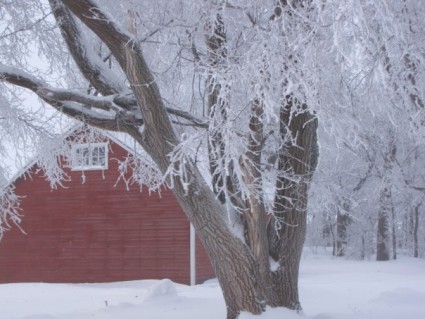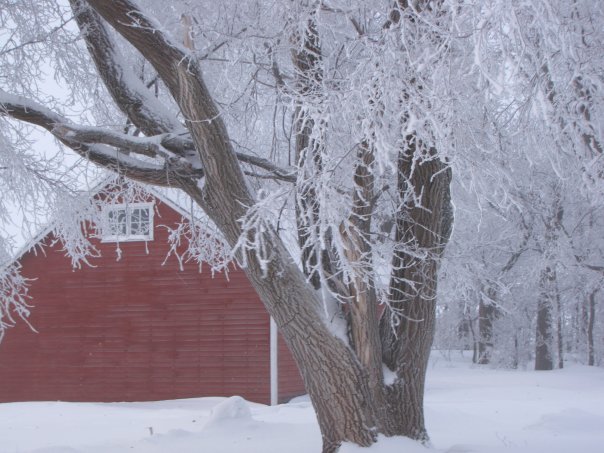 Don’t let the Arctic look fool you — Thistle Root Farm is a beehive of activity. Photo: Steph LarsenSparkling snow blankets a dormant pasture, and a red barn stands out starkly against a sea of white. Winter is a beautiful season on the prairie. Everything looks quiet and peaceful, but there’s still a lot of activity at Thistle Root Farm — most of it indoors. Winter is planning time on our rural Nebraska farm, and we’ve already ordered our seeds and trees, mapped out the 2011 garden rotation, ordered a new tiller, and started preparing for the animal babies that will be arriving soon.
Don’t let the Arctic look fool you — Thistle Root Farm is a beehive of activity. Photo: Steph LarsenSparkling snow blankets a dormant pasture, and a red barn stands out starkly against a sea of white. Winter is a beautiful season on the prairie. Everything looks quiet and peaceful, but there’s still a lot of activity at Thistle Root Farm — most of it indoors. Winter is planning time on our rural Nebraska farm, and we’ve already ordered our seeds and trees, mapped out the 2011 garden rotation, ordered a new tiller, and started preparing for the animal babies that will be arriving soon.
Storms in the past few weeks have left us digging out from under snow drifts, though nothing like the 10- to 12-foot ones we saw last winter. Perpetually cold, I’ve been shivering in sub-zero temperatures, and the wind is like nothing I ever experienced growing up — and I grew up in western Wisconsin. When I read Little House on the Prairie as a child, I scoffed at the idea of needing a rope to guide farmers from house to the barn because the snow was blinding. While I have yet to experience a lack of visibility that extreme, I no longer doubt that it’s possible. Winter can be brutal on the farm, especially when that Great Plains wind gets whipping.
Back in December, I was a little worried that we’d have a dry winter and spring, but we’ve got a healthy snow cover now, insulating the garlic we planted in October. Weather like this brings with it new challenges in caring for livestock, a few of which I wouldn’t have anticipated.
Last fall, in anticipation of the winter cold, we installed a “frost-free waterer” to keep our animals supplied with water in weather that freezes it quickly. It’s a good thing my partner has kept livestock before, because I would never have even known there was such a thing. The basic design is two barrels stacked vertically and buried 5 feet deep. The water line comes up through the middle of the barrels, and heat from the Earth helps to keep the water unfrozen. Or at least, that’s the idea. It hasn’t worked quite as well as we had hoped, in part because sheep don’t drink as fast as cows, so the water has longer to sit in the pool at the surface and get cold. Fortunately, the waterer also has a light fixture you can plug in to generate additional heat, and when it’s plugged in we have hardly seen ice, even in sub-zero temperatures.
We have a water heater for the chickens too, and occasionally we’ve had to bring their waterer in to defrost it. Harder to manage in the chicken coop, however, is avoiding frozen eggs. Fresh eggs have a small amount of air space in them, but as we all know, water expands when it freezes. If the eggs freeze solid, the shells often crack and must be used immediately. We’ve taken to gathering eggs multiple times a day, but sometimes even that isn’t enough. The frozen eggs don’t go to waste though — Arrow the dog is more than happy to have a treat mixed in his dinner.
The resilience of my animals never ceases to amaze me, especially as I cover myself from head to toe before stepping outside. Though we give the sheep a little extra feed when the mercury drops, their woolly coats seem to be doing their job adequately. I’m not sure what frostbite on sheep would even look like, but they don’t seem to have any problems.
Unlike the chickens. When the cold temperatures really set in, I started seeing smears of blood in random places around the coop — on the feeder, wiped on the nesting boxes, on the feathers of a few of the hens. I couldn’t find any obviously bleeding injuries, so it took me a while to figure out that the large single comb of one of the roosters was the source.
Since I can’t put a hat on him and there’s no heat source in the coop, I’m not sure that there’s any remedy except to pick breeds next year with smaller combs that are less prone to frost bite. I also feel sorry for a few of the hens who have fallen victim to the roosters’ romantic advances — and have lost back feathers as a result. I watch those birds particularly carefully, but have been surprised that they don’t seem worse for the wear.
All these snowstorms are great though, because they show that climate change is a hoax. Right?
Sigh. I’ll let someone else explain the difference between weather and climate, and that climate-change models predict more extreme weather, both hot and cold, as the climate gets warmer overall. As for me, I’ll be preparing for many more wild winters in the coming years.



